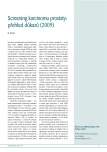PROSTATE BIOPSY CLINICAL AND PATHOLOGICAL VARIABLES THAT PREDICT SIGNIFICANT GRADING CHANGES IN THE CONTEMPORARY ERA
Authors:
S. Moussa; J. Li; M. Soriano; E. A. Klein; F. Dong; J. S. Jones
Authors‘ workplace:
Cleveland Clinic Glickman Urological & Kidney Institute, Cleveland
Published in:
Urol List 2010; 8(1): 23-28
Overview
Purpose:
A significant proportion of prostate cancer patients are upgraded or downgraded on interpretation of radical prostatectomy (RP) pathological specimens. Because biopsy GS plays a critical role in treatment decisions, we sought to identify the clinical and pathological parameters that predict pathological changes.
Materials & Methods:
We retrospectively evaluated a total of 1.397 patients who underwent RP following prostate biopsy at our institution from 2000–2007. We stratify patients according to biopsy Gleason sum into 2 groups, group one: 286 patients with biopsy GS 6. Group two: 1.129 patients with biopsy GS ≥ 7. Complete relevant clinical information was available for all. A multivariable logistic regression analysis was applied to identify predictors of pathological grading changes.
Results:
Following prostatectomy, over all the final pathological GS was found to be upgraded in 430 pa tients (30.8 %), downgraded in 210 (15 %), and unchanged in 757 (54.2%). In Group one (GS 6) 134 patients (50 %) were upgraded postoperatively to GS 7 or higher. In Group 2 (GS ≥ 7), the GS was upgraded in 296 patients (26.2 %), downgraded in 210 (18.6 %), and remained the same in 623 (55.2 %). Factors predicting surgical GS upgrade were higher PSA (p = 0.004), the number of cores positive for cancer (p < 0.001), the percentage of cancer in the extracted tissue (p = 0.002), and the maximum percentage of cancer in any core (p = 0.012). Also the presence of perineural invasion (p = 0.043), absence of inflammation (p < 0.0001), and absence of associated HGPIN (p = 0.0199) were predictors of upgrading. Large prostate volume (p = 0.0041) and low maximum percentage cancer in any core (p = 0.0014) were predictors of downgrading.
Conclusion:
Men with higher PSA, perineural invasion, and high volume cancer at biopsy are most likely to be upgraded while men with large prostate volume, and low volume cancer at biopsy are more likely to be downgraded. These findings carry implications for men with prostate cancer managed without prostatectomy confirmation of their true Gleason scores.
Key words:
biopsy, surgical specimen, prostate cancer, Gleason score, grade migration
Sources
1. Rubin MA, Bismar TA, Curtis S et al. Prostate needle biopsy reporting: how are the surgical members of the Society of Urologic Oncology using pathology reports to guide treatment of prostate cancer patients? Am J Surg Pathol 2004; 28(7): 946–952.
2. Epstein JI, Partin AW, Sauvageot J et al. Prediction of progression following radical prostatectomy. A multivariate analysis of 721 men with long-term follow-up. Am J Surg Pathol 1996; 20(3): 286–292.
3. Oesterling JE, Brendler CB, Epstein JI et al. Correlation of clinical stage, serum prostatic acid phosphatase and preoperative Gleason grade with final pathological stage in 275 patients with clinically localized adenocarcinoma of the prostate. J Urol 1987; 138(1): 92–98.
4. Schmid H, Oberpenning F, Pummer K. Diagnosis and staging of prostatic carcinoma: what is really necessary? Urol Int 1999; 63(1): 57–61.
5. Herman CM, Kattan MW, Ohori M et al. Primary Gleason pattern as a predictor of disease progression in gleason score 7 prostate cancer: a multivariate analysis of 823 men treated with radical prostatectomy. Am J Surg Pathol 2001; 25(5): 657–660.
6. Partin AW, Kattan MW, Subong EN et al. Combination of prostate-specific antigen, clinical stage, and Gleason score to predict pathological stage of localized prostate cancer. A multi-institutional update. JAMA 1997; 277(18): 1445–1451.
7. Fukagai T, Namiki T, Namiki H et al. Discrepancies between Gleason scores of needle biopsy and radical prostatectomy specimens. Pathol Int 2001; 51(5): 364–370.
8. Altay B, Kefi A, Nazli O et al. Comparison of Gleason scores from sextant prostate biopsies and radical prostatectomy specimens. Urol Int 2001; 67(1): 14–18.
9. MontesinoSM, JimenezAJ, ReparazRB et al. Correlation between Gleason score on prostate biopsies diagnostic of adenocarcinoma and radical prostatectomy specimens. Arch Esp Urol 2004; 57(5): 519–523.
10. Arellano L, Castillo O, Metrebian E. Concordance of Gleason histological scoring for prostatic cancer in needle biopsies and the surgical piece obtained during radical prostatectomy. Rev Med Chil 2004; 132(8): 971–978.
11. Cookson MS, Fleshner NE, Soloway SM et al. Correlation between Gleason score of needle biopsy and radical prostatectomy specimen: accuracy and clinical implications. J Urol 1997; 157(2): 559–562.
12. Mosse CA, Magi-Galluzzi C, Tsuzuki T et al. The prognostic significance of tertiary Gleason pattern 5 in radical prostatectomy specimens. Am J Surg Pathol 2004; 28(3): 394–398.
13. Mian BM, Lehr DJ, Moore CK et al. Role of prostate biopsy schemes in accurate prediction of Gleason scores. Urology 2006; 67(2): 379–83.
14. King CR, McNeal JE, Gill H et al. Extended prostate biopsy scheme improves reliability of Gleason grading: implications for radiotherapy patients. Int J Radiat Oncol Biol Phys 2004; 59(2): 386–391.
15. Carlson GD, Calvanese CB, Kahane H et al. Accuracy of biopsy Gleason scores from a large uropathology laboratory: use of a diagnostic protocol to minimize observer variability. Urology 1998; 51(4): 525–529.
16. Kojima M, Troncoso P, Babaian RJ. Use of prostate-specific antigen and tumor volume in predicting needle biopsy grading error. Urology 1995; 45(5): 807–812.
Labels
Paediatric urologist UrologyArticle was published in
Urological Journal

2010 Issue 1
Most read in this issue
- SURGICAL TECHNIQUE FOR LAPAROSCOPIC ADRENALECTOMY
- LAPAROSCOPIC PARTIAL NEPHRECTOMY
- LAPAROSCOPIC RECONSTRUCTION SURGERY OF UPPER URINARY SYSTEM IN CHILDREN – TECHNICAL ASPECTS
- TECHNICAL ASPECTS OF PERFORMING OF TRANSPERITONEAL LAPAROSCOPIC NEPHRECTOMY
